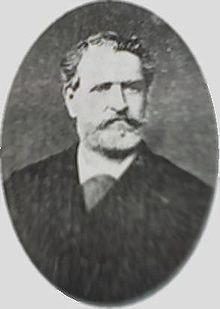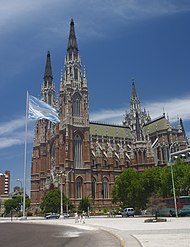
La Plata is the capital city of Buenos Aires Province, Argentina. According to the 2022 census, it has a population of 772.618 and its metropolitan area, the Greater La Plata, has 938.287 inhabitants. It is located 9 kilometers inland from the southern shore of the Río de la Plata estuary.

The La Plata Astronomical Observatory is an observatory located in the city of La Plata, capital of the province of Buenos Aires, Argentina. Its IAU code is 839.

A partido is the second-level administrative subdivision only in the province of Buenos Aires, Argentina. They are formally considered to be a single administrative unit, usually contain one or more population centers, and are divided into localidades. The subdivision in partidos in Buenos Aires Province is distinct from all other provinces of Argentina, which call their second-level subdivisions departamento and are further subdivided into distinct municipalities.

Morón is a city in the Argentine province of Buenos Aires, capital of the Morón partido, located in the Greater Buenos Aires metropolitan area, at 34°39′S58°37′W. Located 20 km (13 mi) west of Downtown Buenos Aires, Morón is easily reached via bus along Avenida Rivadavia, via National Highway 7, and the Sarmiento railway line.

Ensenada Partido is a district of Buenos Aires Province, Argentina, belonging to the Greater La Plata area, just south of the Gran Buenos Aires urban conglomerate.
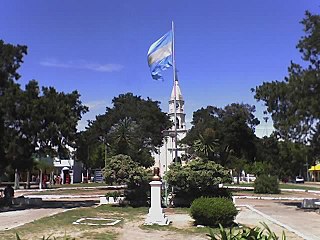
Merlo is the head town of the eponymous partido of Merlo and seat of the municipal government, located in the Greater Buenos Aires urban area of Buenos Aires Province, Argentina.

The Buenos Aires & Ensenada Port Railway (BA&EP) was a British-owned company that built and operated a 5 ft 6 in broad gauge railway network in Argentina towards the end of the nineteenth century. The company was taken over by its rival the British-owned Buenos Aires Great Southern Railway (BAGS) in 1898.

The Ensenada de Barragán is a small bay on the Río de la Plata, some 40 kilometres (25 mi) southeast of Buenos Aires, Argentina. The area is in the Ensenada district of Buenos Aires province, centred on the city of the Ensenada. The old cove has partly silted since the 17th century, and the area is now considered to be part of Isla Santiago.

The La Plata Museum is a natural history museum in La Plata, Argentina. It is part of the Facultad de Ciencias Naturales y Museo of the National University of La Plata.

Dardo Rocha was an Argentine naval officer, lawyer and politician best known as the founder of the city of La Plata and of the University of La Plata.

Luis Augusto Huergo was an Argentine engineer prominent in the development of his country's ports.

La Plata City Hall is the executive seat of government of the city of La Plata, the capital of Buenos Aires Province, Argentina.
Events in the year 1884 in Argentina.
Francisco López de Osornio Merlo was a Spanish military leader and landowner, who served during the Viceroyalty of Peru as Captain of the provincial militias of Buenos Aires.
Jorge Fernández-Trevejo Rivas is a Cuban artist, painter, and caricaturist. He currently resides in Argentina.
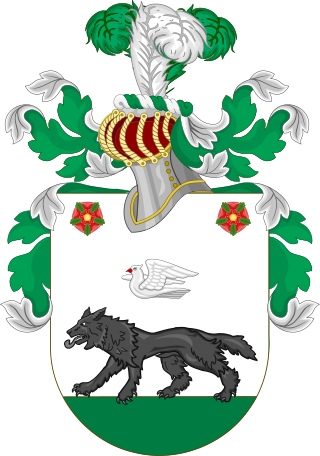
Francisco de Merlo (1693-1758) was a Spanish notary and politician, who served during the Viceroyalty of Peru as Notary Mayor of the Government of Buenos Aires. He was the founder of the city of Merlo, and also took part in the foundation of Montevideo in the Banda Oriental.

Mar del Plata is a former railway station in the homonymous city of Buenos Aires Province, Argentina. Opened in 1886, the station was closed when the new railway and bus terminal was opened in 2011.

Itala Fulvia Villa (1913–1991) was an Argentinian architect whose main forte was city planning. She was an integral part of creating and designing the urban model for the city of Buenos Aires. As part of urbanization process, she designed and built a plan for the neighborhood known as Bajo Flores, where Pope Francis grew up, for which she received first prize in the 6th National Exhibition of Architecture Fair in 1945. In 1979, she was a representative of the Argentina Federation of University Women.
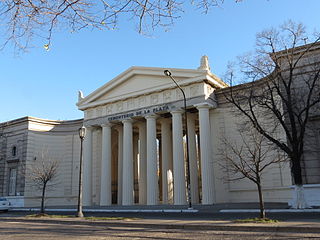
The Cemetery of La Plata is one of the most important cemeteries in Buenos Aires Province, Argentina. It is located on the intersection of Avenue 31, 72 and diagonal 74 in Altos de San Lorenzo, La Plata. It was declared Cultural Heritage and Memorial of Buenos Aires Province.

Mar del Plata Sud is a former railway station in the city of Mar del Plata in Buenos Aires Province, Argentina. Built and managed by the Buenos Aires Great Southern Railway, the station was conceived as an alternative to the original Mar del Plata station built in 1886, only to operate during Summer seasons. The station was inaugurated in 1910. Soon after the Government led by Juan Perón nationalised the entire railway network, the station was closed to reduce costs.
